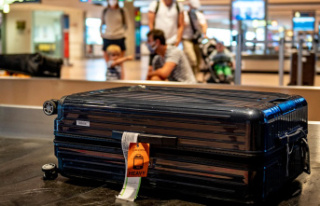Military maneuvers continue around Taiwan. The Taiwan army conducted this Tuesday, August 9, a live ammunition artillery exercise in Pingtung County (south) simulating the defense of the island against a Chinese invasion that the island accuses Beijing of preparing. Several hundred soldiers were deployed, as well as about 40 howitzers, the army said. A new exercise is scheduled for Thursday, August 11. The island regularly holds military exercises simulating a Chinese invasion.
Kinmen Island, just 3.2 km from China, has been in nationalist hands since 1949, when the Chinese Civil War ended.
Screenshot Google Maps
China launched its largest military air and sea maneuvers around Taiwan last week in response to a visit by House Speaker Nancy Pelosi, the highest-ranking US official to visit the self-governing island since decades. Beijing "used the exercises and its military roadmap to prepare for the invasion of Taiwan", accused the head of Taiwan's diplomacy, Joseph Wu, during a press conference in Taipei after the Taiwanese maneuvers.
China considers Taiwan, with a population of around 23 million, to be one of its provinces, which it has yet to successfully reunify with the rest of its territory since the end of the Chinese Civil War (1949 ). An island, on the front line facing China, is particularly eye-catching in this period characterized by renewed tensions: Kinmen, just 3.2 km from China, with a population of just over 100,000 inhabitants. If the Chinese army crossed the Taiwan Strait, it would certainly be its first target.
This small coastal island has been controlled by Taiwan since 1949. Oddly enough, communist forces never managed to conquer it during and after the Chinese Civil War. It thus remained under the control of the Republic of China, the regime that now governs Taiwan.
This rare place where the military forces of the mainland and the island face each other at such a short distance has nevertheless been the scene of bitter fighting between nationalists and communists. The first Taiwan Strait Crisis erupted in August 1954 when Republic of China nationalists deployed thousands of troops to Kinmen and Matsu, another small island a few miles from the mainland. Communist China responded with artillery bombardment of the islands and the capture of the Yijiangshan Islands, about 400 kilometers north of Taipei. The crisis was finally defused.
Fighting erupted again in 1958, when Mao Zedong's forces bombarded Kinmen and Matsu in an attempt to dislodge Nationalist troops from them again. Fearing that the loss of these islands would lead to the collapse of the nationalists and the seizure of Taiwan by Beijing, US President Dwight D. Eisenhower ordered his military to escort and resupply their Taiwanese allies. The United States even briefly considered using nuclear weapons against China. In 1958, Kinmen Island was bombarded relentlessly by the People's Liberation Army (PLA) for 44 days: 500,000 shells were launched in 44 days at Nationalist soldiers, killing hundreds.
Unable to take the islands near its coasts or subjugate the nationalists with its bombardments, Beijing then announced a ceasefire. A tense status quo then set in, but Mao's forces continued to bombard Kinmen intermittently until 1979. The island, which made knives its specialty - iron from ancient Chinese bombs - long housed a military base. Tens of thousands of mines still dotted the island's shore until recently. On the road, signs still regularly indicate the way to shelters or military tunnels.
Until 1992, Kinmen's economy was exclusively dependent on the 150,000 soldiers stationed on the island, while the military represented a larger population than the civilians. But the island, which has built a large shopping center, the Everrich Plaza, experienced a new lease of life in the early 2000s and opened up to tourism. On January 2, 2001, direct sea links between Kinmen and Chinese ports were inaugurated. Every day, 24 maritime shuttles were thus provided between Kinmen and the Chinese cities of Xiamen (4.2 million inhabitants) and Quanzhou (7.6 million inhabitants). On March 3, 2014, a Chinese boat also provided the first official link between the mainland and Taiwan in half a century, arriving on Kinmen Island.
As Mediapart reports, on January 2, 2019, while delivering a speech at an event celebrating the 40th anniversary of the "message to Taiwanese compatriots", the Chinese leader Xi Jinping explicitly mentioned Kinmen for the opening of the "four new routes". , namely electricity, gas, bridges and water.
However, since 2019, due to tensions between Taipei and Beijing and the Covid-19 pandemic, it has become impossible to directly cross the tiny inlet marking the border between the People's Republic of China and the Republic of China.
As Le Figaro reminds us, on the political level, Kinmen is a traditional stronghold of the Kuomintang (KMT), long a single party and today the main opposition party in Taiwan. In Kinmen, very few candidates for the elections wear the colors of the Democratic Progressive Party (PDP), in power in Taipei. "The political and identity divide that is generally observed in Taiwan, a part of the population which wishes to see an independent Taiwan in the long term against another which wishes to see the country reunited with China] is not applicable to Kinmen. independence ambitions of the PDP, real or supposed, mean, for many Kinmenois, to see Kinmen abandoned in favor of the People's Republic of China", explained in 2020 to Mediapart Alexandre Gandil. According to this doctoral student in political science working on Kinmen, "Taiwan's independence is out of all consideration. We want to get closer to China economically, for practical matters, to maintain a comfortable life, but most people don't want not fit into Beijing's political system." Will they one day have to?












